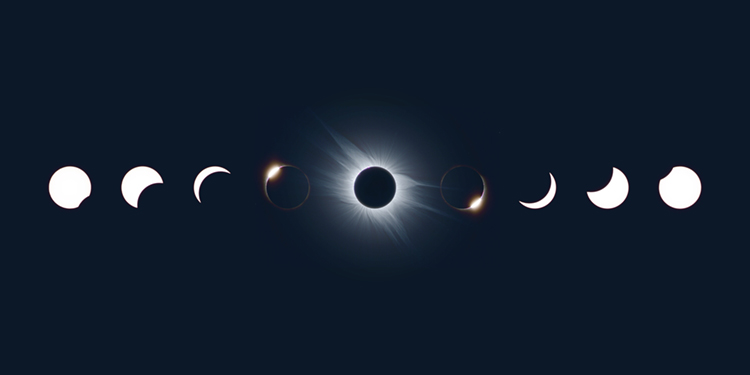Get ready! On Monday, August 21, if you live in the United States from Oregon to South Carolina, you will be able to experience one of nature’s most impressive sights–a total eclipse of the sun. Across the United States, large crowds are expected in towns, cities, and campsites along the path of totality for the spectacular celestial show. The path of totality is the narrow swath, about 70 miles (110 kilometers) wide, along which the moon will completely blot out the sun.
A total solar eclipse occurs when the Earth, sun, and moon are in nearly a straight line and the moon’s shadow sweeps across the face of Earth. The dark moon appears on the edge of the sun and moves slowly across. At the moment of totality, a brilliant halo flashes into view around the darkened sun. This halo is the sun’s outer atmosphere, the corona. The sky remains blue but darkens dramatically. Some bright stars and planets will become visible and the temperature will noticeably drop. After a few minutes, the sun reappears as the moon continues on its orbit. The period when the sun is totally darkened may be as long as 7 minutes 40 seconds, but it averages about 2 1/2 minutes.

A total eclipse of the sun, as shown here, starts at the left. The moon gradually covers the sun, shown photographed through a filter. At the time of the total eclipse, photographed without a filter, the sun’s corona (outer atmosphere) flashes into view. The sun reappears as the moon moves on. Credit: © Atlas Photo Bank/ Photo Researchers
In the United States, the path of totality will cross 14 states: Oregon, Idaho, Wyoming, Montana, Nebraska, Iowa, Kansas, Missouri, Illinois, Kentucky, Tennessee, Georgia, North Carolina, and South Carolina. This will be the first total solar eclipse to cross the United States from coast-to-coast since June 8, 1918, when a total solar eclipse darkened skies from Washington to Florida. The last total solar eclipse to be seen anywhere in the continental United States was in 1979.
Makanda, a village in southern Illinois just south of Carbondale, will see the longest duration of totality for the eclipse–about 2 minutes and 40 seconds. If you miss out, though, don’t worry. Another total solar eclipse will cross the same area in 2024!
If you are going to view the eclipse, be careful! Looking directly at the sun, even during an eclipse, can severely damage your eyes, even if you are wearing sunglasses. If you wish to look directly at the eclipse you will need “eclipse glasses” which have special solar filters. Make sure that your eclipse glasses are undamaged and meet safety standards. Be careful to look away from the sun when you put your eclipse glasses on and take them off. A total solar eclipse can be viewed safely without protection in the path of totality only during the brief time when the disk of the sun is completely hidden.
More on this story next week!
Untitled Document Can't view the linked articles? Subscribe to World Book Online

World Book Online delivers a progressive sequence of core databases supported by supplemental
tools, such as language translation, graphic organizers, and unique Webquests. Moving from
Early World of Learning to World Book Advanced, World Book Online aligns end-users with their
appropriate learning levels. Each stand-alone site provides additional features to support the
needs of users’ specific capabilities.
The World Book Difference
World Book combines cutting-edge technology with traditional editorial excellence to produce
authoritative, trustworthy, and unbiased content. The digital content is updated in real time and
carefully curated for each learning level. Accessible 24/7, the content is available on a variety of devices.
World Book Online combines 21st-century instructional techniques with timely information.
By breaking down complex topics and using easily understandable text, World Book Online helps to
build fluency and increase comprehension. Featuring single sign-on capability, these sites are paired
with highly visual content to engage even the most reluctant reader. Our collection of resources kindles
a lifelong learning experience for every user. This adherence to clarity, currency, and accuracy makes
World Book’s digital offerings an information hub for the classroom, library, and beyond.
|